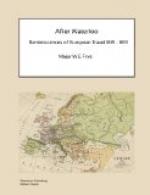On the Ponte Vecchio on each side are jewellers’ shops, who sell besides jewellery, cameos and works in mosaic. The Quais on each side of the Arno are very broad and spacious and form agreeable promenades in the winter season. The buildings on the banks of the Arno are magnificent. The streets of Florence have this peculiarity that they are all paved with large flag stones, which makes them mightily pleasant for pedestrians, but dangerous at times for horses who are apt to slip. Most of the houses in Florence have walls of prodigious thickness; one would suppose each house was meant to be a fortress in case of necessity.
FLORENCE, 29th August.
On the other side of the Arno, a little beyond the Cabinet Physique and Museum of Natural History stands the Palazzo Pitti, the residence of the Grand Duke. It is a vast building and has a large and choice collection of pictures; but its finest ornament in my opinion is the statue of Venus by Canova, which to me at least appears to equal the Medicean Venus in beauty and in grace. The magnificent and spacious garden belonging to the Palace is called the garden of Boboli. These gardens form the grand promenade of the Florentines on Sundays and holidays. The alleys are well shaded by trees, which effectually protect the promenaders from the rays of the sun. There are a great many statues in this garden, but the most striking is a group which lies nearly in the centre of the garden. It is environed by a large circular basin or lake lined with stone and planted with orange trees on the whole circumference. In the centre of the lake is a rock and on this rock is a colossal statue in white marble of Neptune in his car. The car is in the shape of a marine conch and serves as a basin and fountain at the same time. There are several other fountains and jets d’eau, among which is a group representing Adam and Eve and the statue of a man pouring out water from a vase which he has on his shoulder.
The Corso or grand evening promenade for carriages and equestrians is on a place called the Cascino, pronounced by the Florentines Hascino. The Cascino consists of pleasure grounds on the banks of the Arno outside the town, laid out in roads, alleys and walks for carriages, equestrians and pedestrians. There is a very brilliant display of carriages every evening. There are restaurants on the Cascino and supper parties are often formed here. This place is often the scene of curious adventures. Cicisbeism is universal at Florence, tho’ far from being always criminal, as is generally supposed by foreigners. I find the Florentine women very graceful and many very handsome; but in point of beauty the female peasantry far exceed the noblesse and burghers. All of them however dress with taste. The handsomest woman in Florence is the wife of an apothecary who lives in the Piazza del Duomo and she has a host of admirers.




